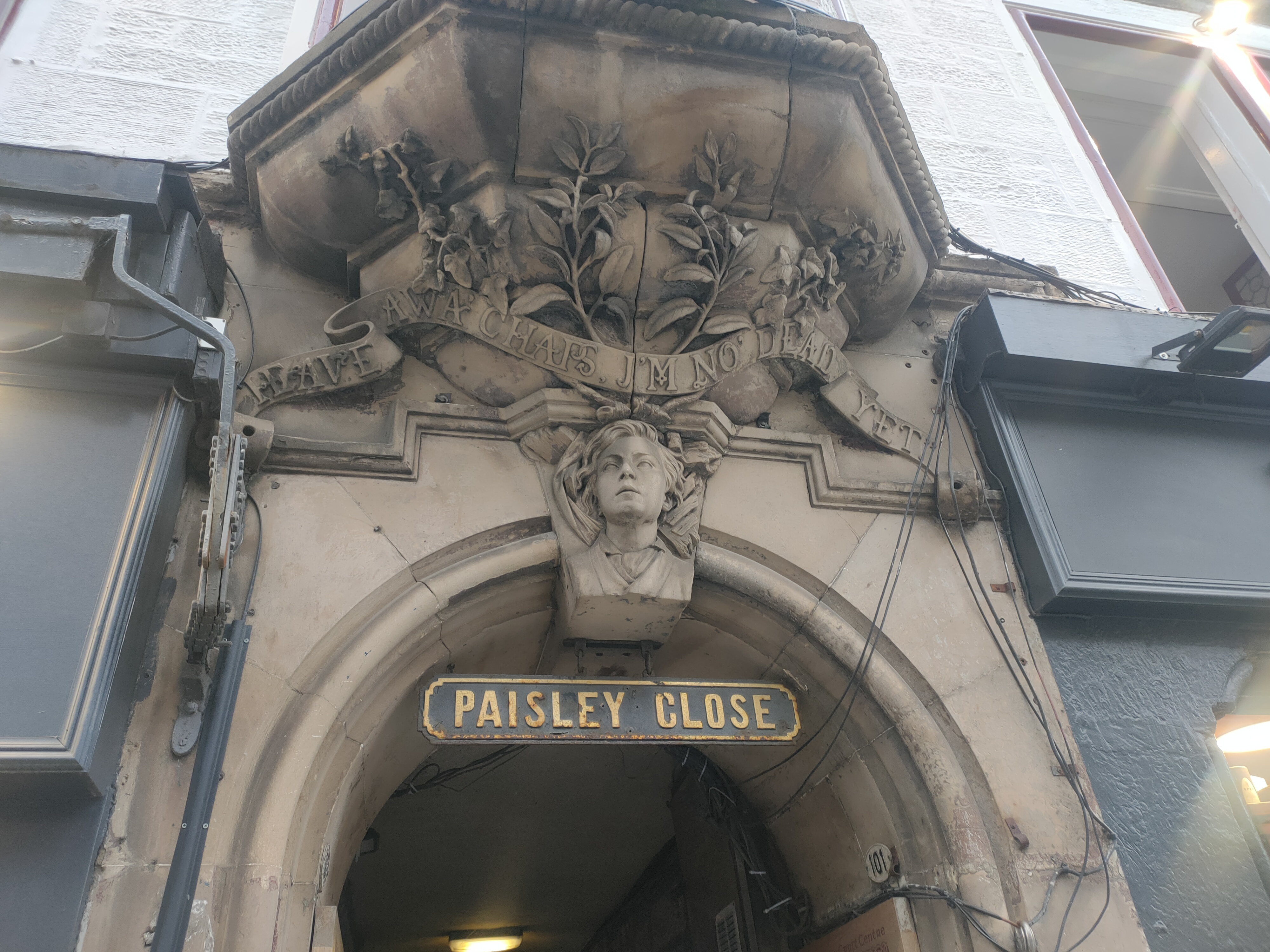Welcome to “Walking Woods Edinburgh”, a self-guided audio tour around the centre of Edinburgh that takes a closer look at the history of the city through the eyes of a wood scientist. The tour was developed as part of the 20th annual meeting of the Northern European Network for Wood Science and Engineering (WSE), but it is meant to be interesting for wood scientists and laypeople alike.
Go to the route map and list of stops
Download transcript of the episode.
This time there is not much more to see than what meets the eye, although some illustrations of the disaster made it into newspapers at the time. The “Heave Awa Hoose” does not exist anymore, only the inscription above Paisley Close survived into modern age:

Well, hopefully some lessons from the disaster that Susan and I talked about also survived until now. As I said, many building regulations came to be because of disasters like this one. The Great Fire of London probably directly impacted the decline of timber being used as a structural material. Nowadays we are using timber in structures again, which is probably largely influenced by the decline of open fire heating, but also by us taking a more nuanced approach to safety in design and building performance.
Modern building regulations don’t only allow specific materials and systems to be used, but also have a route to market for novel building products via performance demonstration. For example, if a wall panel can withstand fire for a certain time, as demonstrated by a fire test of the whole system, it can be used for building. Standardised tests are used for different performance criteria. In a similar way, engineered wood products like glulam can be used for structural purposes even where there is no strength grading assignment for the individual timbers. The whole product can be tested and mechanical properties demonstrated this way.
Even though our building regulations are safer now than in 1861, there is still room for error. In many ways the Grenfell Tower disaster is eerily similar to the collapse of the Heave Awa Hoose. And this happened in 2017. Many factors contributed to the severe consequences of the fire, and building regulations and building control seem to have been partly responsible: Inadequate testing for demonstrating compliance with the fire regulations was kept in Approved Document B for long after a new test standard had been developed to better reflect real-life performance. Furthermore, the results of tests that suggested that certain cladding systems were failing the fire-performance tests were ignored. When the guidance was finally updated, the wording chosen did not make it very clear that these dangerous cladding-insulation-systems were not compliant with building regulations.
Many other factors played a role as well, not lastly the importance that we put on the lives of social housing occupants vs. commercial interests.
This sad story, too, prompted a review of building regulations. But increasing safety is a balance game with practicality and efficiency, and the pendulum can quickly swing to the other extreme, unless a very nuanced approach is taken. Before the changes came into place, my colleague Ivor summarised how some of the proposed changes would negatively affect the timber industry, and, unfortunately, all of his points still stand, because the building regulations now prohibit the use of combustible materials (Class A2-s1,d0 and A1) in the external walls of residential buildings above 18 m, or 6 stories, high. The ban means that a large opportunity for mid-rise construction with engineered wood products will be missed in the UK, when challenges in fire safety could have been addressed with design details and the use of sprinkler systems, as it is done in other European countries. This also means a missed opportunity for decarbonising our built environment and for the home-grown timber industry.
Because, as Susan and I highlighted, when a building fails, it’s not the timber’s fault. We are well aware that timber, as a natural material, has some drawbacks that we best address in our design. Apart from keeping wood away from fire (or designing in a way that gives people enough time to escape), the most important advice in timber design is: Keep it dry! If the timber in Heave Awa Hoose had been dry, we’d have not had damp smell and buckling, and even the collapse might have well been due to decay of the timber by fungi. In our modern timber construction, guidance puts much emphasis on keeping the timber dry, during construction as well as in use. Of course, it remains really important to actually follow best practice even on a messy construction site.
It is also quite important to pay attention to signs that suggest something might be wrong, well before tenants start to complain that their walls are buckling. But modern buildings require modern solutions. Because the timber structure is not always visible, visual inspection as we do it in historic buildings will not always be enough to detect faults in time. We will probably see more and more smart buildings, that monitor their own condition with sensors. The New Model Institute for Technology and Engineering (NMITE) shows how this can be done: Their new timber building uses 48 moisture sensors to monitor the condition of CLT panels. And even more innovative solutions are on the horizon: Maybe the CLT panels themselves will be moisture sensors in the future!
Next stop: Holyrood Park
